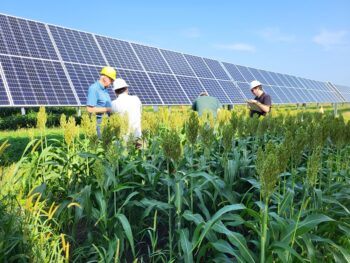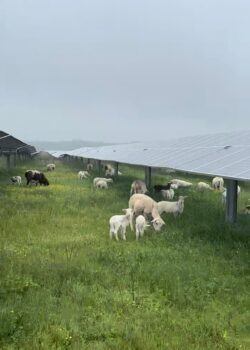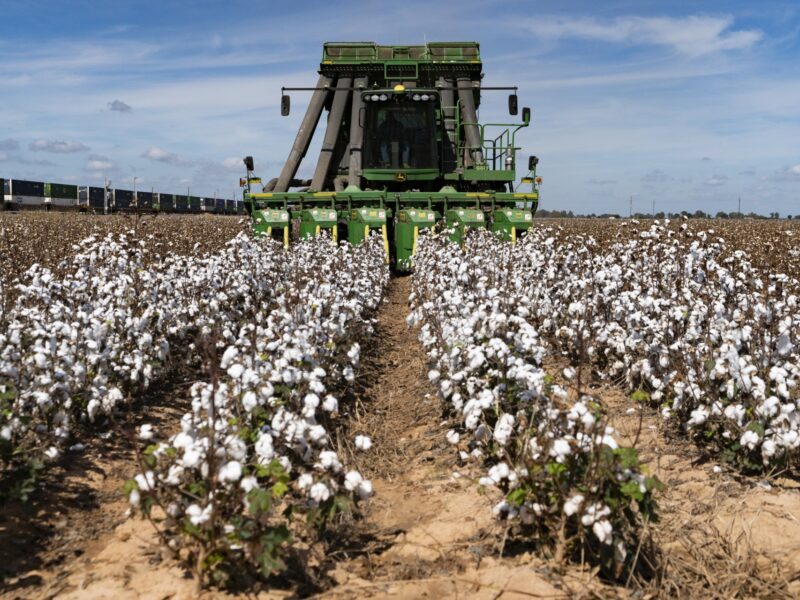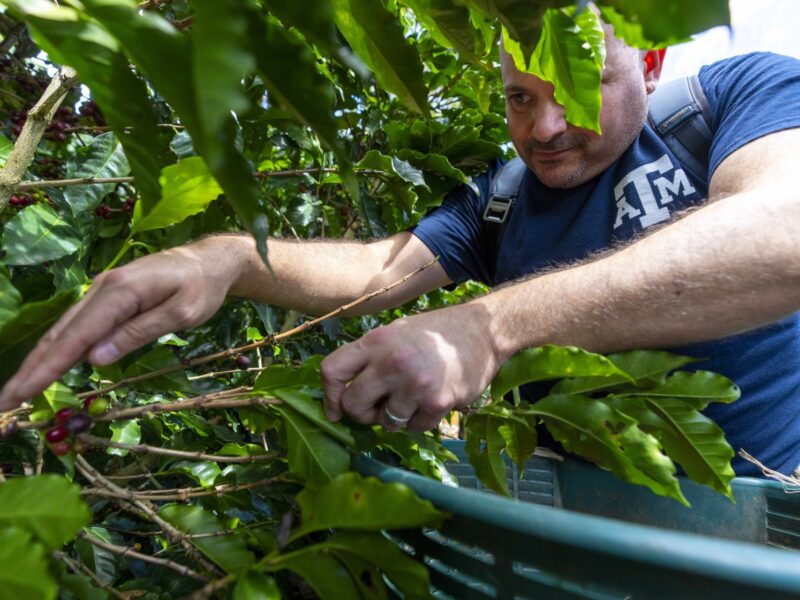Putting The ‘Farm’ In Solar Farm

Scientists with Texas A&M AgriLife seek to make solar energy production and agricultural production more compatible for producers on the landscape.
Researchers are actively contributing to the growing body of research focused on agrivoltaics — an innovative technology with the potential to enhance the efficiency and resiliency of sustainable food and agricultural systems while feeding the state’s growing demand for energy.
While Texas leads the nation in energy production, thanks to its diverse reserves of fossil fuels and renewable energy resources, the state’s rapidly expanding population places an ever-growing demand on the electrical power grid. This year, the Electric Reliability Council of Texas reported an unofficial record demand of 85,435 megawatts during the summer heatwave.
Photovoltaic systems, commonly known as solar power or solar panel arrays, play an important role in meeting these growing energy requirements, but the installations are land intensive and can compete with areas also suitable for agricultural production.
That’s where agrivoltaics comes in.
Agrivoltaics Enhances Land Use
As the term implies, agrivoltaics is a dual land-use system combining agriculture in the form of crop and livestock production with solar power arrays.
“As the population of Texas continues to grow, we will see limitations in the amount of land available for the production of food and other agricultural commodities,” said Dr. Nuria Gomez-Casanovas, assistant professor in regenerative system ecology in the Texas A&M College of Agriculture and Life Sciences Department of Rangeland, Wildlife and Fisheries Management.
Gomez-Casanovas said the growing loss of agricultural lands, coupled with expanding energy requirements, has resulted in mounting interest in the potential of agrivoltaic systems.
“Agrivoltaics combines traditional solar arrays with agricultural production between them so we can generate renewable energy while simultaneously producing food,” said Gomez-Casanovas, based at the Texas A&M AgriLife Research and Extension Center at Vernon. “Just picture typical agricultural farming activities with a solar farm.”
Innovative Approach And Unknowns
Despite the promise agrivoltaics holds for agriculture and energy production, the implementation of the system is relatively new, and Gomez-Casanovas said many questions remain unanswered.
To establish a foundation of existing knowledge and guide future research priorities, Gomez-Casanovas and a team of researchers from across the country collaborated on a recent paper published in Cell Reports Physical Science. The publication, “Knowns, Uncertainties and Challenges in Agrivoltaics to Sustainably Intensify Energy and Food Production,” is a comprehensive analysis of existing scientific literature to assess the potential of agrivoltaics in enhancing sustainable food and energy production systems.
“We reviewed existing scientific literature to assess how agrivoltaics can provide synergistic benefits across the food-energy-water nexus compared to solar power arrays or agricultural systems alone,” Gomez-Casanovas said. “One of the take-home messages from our analysis is enhanced land productivity through the implementation of agrivoltaics.”

Making Land More Productive
The idea is to make each acre more profitable for landowners and agricultural operations, said Gomez-Casanovas. Agrivoltaics represents a dual-income stream from food and energy production.
Using a formula known as the land equivalency ratio, the researchers found that planting agricultural crops under solar panel arrays can enhance land productivity by up to 60% compared to crop monocultures or solar panel arrays on the same land area.
Further, the vegetation planted under these solar arrays can offset several undesirable outcomes associated with widespread implementation of solar arrays.
“In a photovoltaic system, vegetation is often removed or kept low under the solar panels, which can result in biodiversity loss associated with land conversion and clearing, as well as an increase in local temperatures due to what is known as the photovoltaic heat island effect,” Gomez-Casanovas said.
Similar to the urban heat island effect, this increase in local temperature is the result of the loss of natural land coverage and an abundance of human-made materials that absorb and retain heat.
Water Efficiency And Heat Abatement For Agricultural Production
While most of Texas’ solar arrays are located in the vast, arid regions of West Texas where crop production can be a challenge, Gomez-Casanovas said agrivoltaic systems could boost solar energy production and agricultural resiliency in semi-arid regions of the state.
“Because the solar panels provide shade to the plants, less solar radiation reaches them, resulting in a reduction in soil water evaporation and plant transpiration,” Gomez-Casanovas said. “This is very beneficial for plant health during intense summers and periods of drought.”
This reduction in plant water loss ultimately translates to water savings in irrigation—an important factor for agricultural production and resource conservation as Texas faces growing demands for water amid rising scarcity.
“Although shading might be expected to lower plant productivity, and it does in certain agricultural settings, there is increasing evidence that agrivoltaics has the potential to enhance crop and forage yields compared to traditional agricultural systems alone,” Gomez-Casanovas said.
For example, a 2019 study found a two-fold increase in yields from tomato and chiltepin peppers grown under solar panels in a semi-arid environment compared to a traditional agricultural system.
She notes, however, that different plant species have varying light requirements, so further research regarding panel configuration and plant selection is needed to better understand how crop yields under solar panels can be enhanced.
In addition to benefiting plant growth, Gomez-Casanovas said agrivoltaics could enhance animal production on grazing lands with the shade provided by solar panels reducing livestock heat stress.
Carbon Accrual and Biodiversity
The increased plant productivity seen in optimized agrivoltaic systems can also translate to increased carbon sequestration through above- and below-ground plant biomass.
However, research shows that prior land use is a key factor in predicting the impact of agrivoltaics on carbon accrual.
“For example, if you transition a native rangeland to an agrivoltaic system, there is a detrimental impact on carbon sequestration,” Gomez-Casanovas said. “However, if you transition from an agricultural system with low soil organic carbon to an agrivoltaic system promoting carbon buildup, there would be a positive impact.”
She notes that plants used, varying soil types and agricultural practices implemented also influence the impact agrivoltaics can have on carbon sequestration.
Strategic management of vegetation under the arrays, such as the restoration of native vegetation or planting pollinator-friendly species can also have a positive impact on biodiversity, Gomez-Casanovas said.
Limiting Factors To Implementation
While robust crop yields and supplemental energy production may seem like a win-win in the mind of producers, Gomez-Casanovas said the implementation of an agrivoltaic system involves significant upfront capital cost and a long-term investment horizon that integrates production risks.
“The profitability of agrivoltaics is expected to play an important role in farmers’ decisions to adopt the system,” Gomez-Casanovas said. “From a producer perspective, there are many questions that need to be answered.”
Among these questions are the large-scale infrastructure needed for energy storage and transmission, as well as energy pricing, ideal crop selection, solar array configuration and policy support such as investment tax credit and production tax credit to make agrivoltaics as competitive as possible, among others.
“At this point, we have more questions than answers, which is exciting because these questions will guide our future cross-discipline research,” Gomez-Casanovas said.
Media contact: Sarah Fuller, sarah.fuller@ag.tamu.edu





